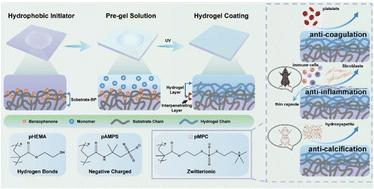当前位置:
X-MOL 学术
›
Biomater. Sci.
›
论文详情
Our official English website, www.x-mol.net, welcomes your feedback! (Note: you will need to create a separate account there.)
Comparison study of surface-initiated hydrogel coatings with distinct side-chains for improving biocompatibility of polymeric heart valves
Biomaterials Science ( IF 6.6 ) Pub Date : 2024-04-12 , DOI: 10.1039/d4bm00158c Yiduo Chen 1 , Yirong Guo 1 , Xinyi Li 1 , Yanchen Chen 1 , Jiarong Wang 1 , Honglin Qian 1 , Jing Wang 1, 2 , Youxiang Wang 1 , Xinyang Hu 2 , Jian'an Wang 2 , Jian Ji 1, 2
Biomaterials Science ( IF 6.6 ) Pub Date : 2024-04-12 , DOI: 10.1039/d4bm00158c Yiduo Chen 1 , Yirong Guo 1 , Xinyi Li 1 , Yanchen Chen 1 , Jiarong Wang 1 , Honglin Qian 1 , Jing Wang 1, 2 , Youxiang Wang 1 , Xinyang Hu 2 , Jian'an Wang 2 , Jian Ji 1, 2
Affiliation

|
Polymeric heart valves (PHVs) present a promising alternative for treating valvular heart diseases with satisfactory hydrodynamics and durability against structural degeneration. However, the cascaded coagulation, inflammatory responses, and calcification in the dynamic blood environment pose significant challenges to the surface design of current PHVs. In this study, we employed a surface-initiated polymerization method to modify polystyrene-block-isobutylene-block-styrene (SIBS) by creating three hydrogel coatings: poly(2-methacryloyloxy ethyl phosphorylcholine) (pMPC), poly(2-acrylamido-2-methylpropanesulfonic acid) (pAMPS), and poly(2-hydroxyethyl methacrylate) (pHEMA). These hydrogel coatings dramatically promoted SIBS's hydrophilicity and blood compatibility at the initial state. Notably, the pMPC and pAMPS coatings maintained a considerable platelet resistance performance after 12 h of sonication and 10 000 cycles of stretching and bending. However, the sonication process induced visible damage to the pHEMA coating and attenuated the anti-coagulation property. Furthermore, the in vivo subcutaneous implantation studies demonstrated that the amphiphilic pMPC coating showed superior anti-inflammatory and anti-calcification properties. Considering the remarkable stability and optimal biocompatibility, the amphiphilic pMPC coating constructed by surface-initiated polymerization holds promising potential for modifying PHVs.
中文翻译:

具有不同侧链的表面引发水凝胶涂层用于改善聚合物心脏瓣膜生物相容性的比较研究
聚合物心脏瓣膜(PHV)为治疗瓣膜性心脏病提供了一种有前途的替代方案,具有令人满意的流体动力学和抗结构退化的耐久性。然而,动态血液环境中的级联凝血、炎症反应和钙化对当前 PHV 的表面设计提出了重大挑战。在这项研究中,我们采用表面引发聚合方法通过创建三种水凝胶涂层来改性聚苯乙烯-嵌段-异丁烯-嵌段-苯乙烯(SIBS):聚(2-甲基丙烯酰氧基乙基磷酰胆碱)(pMPC)、聚(2-丙烯酰氨基- 2-甲基丙磺酸)(pAMPS)和聚(甲基丙烯酸 2-羟乙酯)(pHEMA)。这些水凝胶涂层极大地提高了 SIBS 在初始状态下的亲水性和血液相容性。值得注意的是,pMPC 和 pAMPS 涂层在 12 小时超声处理和 10 000 次拉伸和弯曲循环后仍保持相当大的抗血小板性能。然而,超声处理过程对 pHEMA 涂层造成明显损伤,并削弱了抗凝性能。此外,体内皮下植入研究表明,两亲性pMPC涂层表现出优异的抗炎和抗钙化特性。考虑到卓越的稳定性和最佳的生物相容性,通过表面引发聚合构建的两亲性pMPC涂层在改性PHV方面具有广阔的潜力。
更新日期:2024-04-15
中文翻译:

具有不同侧链的表面引发水凝胶涂层用于改善聚合物心脏瓣膜生物相容性的比较研究
聚合物心脏瓣膜(PHV)为治疗瓣膜性心脏病提供了一种有前途的替代方案,具有令人满意的流体动力学和抗结构退化的耐久性。然而,动态血液环境中的级联凝血、炎症反应和钙化对当前 PHV 的表面设计提出了重大挑战。在这项研究中,我们采用表面引发聚合方法通过创建三种水凝胶涂层来改性聚苯乙烯-嵌段-异丁烯-嵌段-苯乙烯(SIBS):聚(2-甲基丙烯酰氧基乙基磷酰胆碱)(pMPC)、聚(2-丙烯酰氨基- 2-甲基丙磺酸)(pAMPS)和聚(甲基丙烯酸 2-羟乙酯)(pHEMA)。这些水凝胶涂层极大地提高了 SIBS 在初始状态下的亲水性和血液相容性。值得注意的是,pMPC 和 pAMPS 涂层在 12 小时超声处理和 10 000 次拉伸和弯曲循环后仍保持相当大的抗血小板性能。然而,超声处理过程对 pHEMA 涂层造成明显损伤,并削弱了抗凝性能。此外,体内皮下植入研究表明,两亲性pMPC涂层表现出优异的抗炎和抗钙化特性。考虑到卓越的稳定性和最佳的生物相容性,通过表面引发聚合构建的两亲性pMPC涂层在改性PHV方面具有广阔的潜力。



























 京公网安备 11010802027423号
京公网安备 11010802027423号